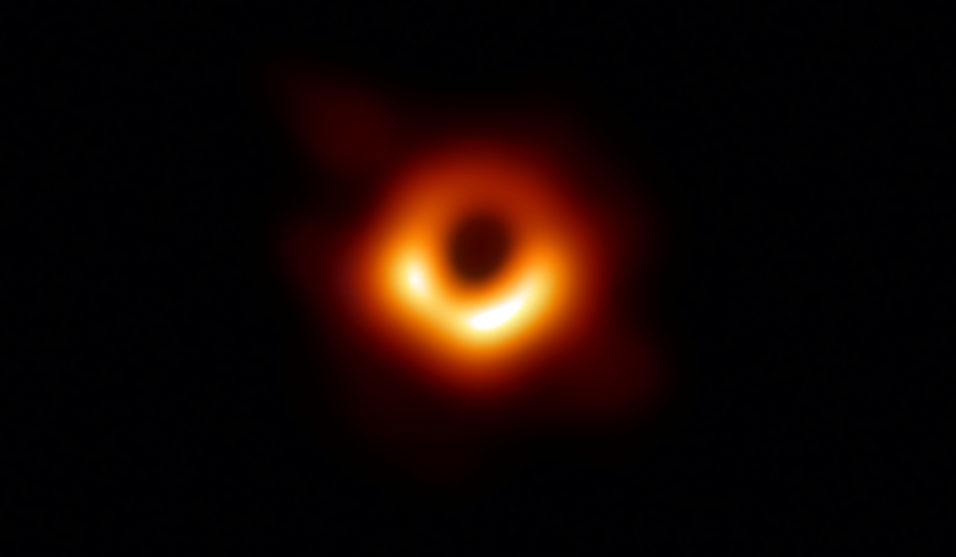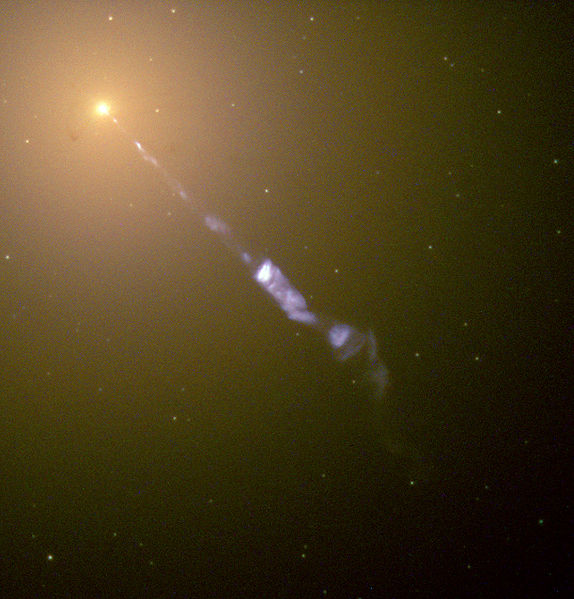Added 1 new A* page:
image by Event Horizon Telescope Collaboration (source)
^ That is the result of the first-ever successful imaging of a black hole; specifically, it shows radio emissions from a ring of plasma rotating at nearly the speed of light around the "shadow" cast by the enormous gravity of the 6.5 billion-solar-mass supermassive black hole M87* at the center of galaxy Messier 87 ("M87"), 53 million light years away from our own galaxy.
The Event Horizon Telescope ("EHT") collaboration, which released the image yesterday, says
"The shadow of a black hole is the closest we can come to an image of the black hole itself, a completely dark object from which light cannot escape. The black hole’s boundary — the event horizon from which the EHT takes its name — is around 2.5 times smaller than the shadow it casts and measures just under 40 billion km across."
Reuters, in a well-written article, notes that puts M87*'s event horizon at "about three times the size of Pluto's orbit around the sun."
The EHT is an international scientific consortium using a global network of coordinated radio telescopes to image black holes. Their other major target is the supermassive black hole at the center of our own galaxy, the radio source designated Sagittarius A*—but A*, a smaller black hole, at about 4 million solar masses, currently does not have a nice glowy accretion disk around it like M87*, which is actively sucking in material, does; and our view of A* is edge-on, so if there was a disk, it would overlap the hole, possibly spoiling the view anyway, although it might be bent or "lensed" around the hole, visually, by the hole's gravity—and, probably more importantly, there's tens of thousands of light years of galactic arm dust and gas between us and our own galactic center. Also, A* is not solidly "on" like M87* is, so its output fluctuates widely, "on the scale of minutes rather than days"; EHT's scans of M87* ran 3-7 minutes each.
Those scans took place on four separate days in 2017; the graphic shown is the result of a very sophisticated cross-analysis of the radio wave readings from the individual telescopes, correlating them into a composite reading, correcting for delays and atmospheric effects, and then constructing an image out of this signal by running it through imaging algorithms based on the most current scientific theories of how light behaves in the proximity of a black hole; and the result is the anticipated lopsided ring, lopsided because light from the side of the tilted accretion disk that is rotating (clockwise) in our direction hits us more energetically than light from the side that is rotating away. Although construction of the image made use of current theory, the fact that the underlying observed data resulted in an image strongly corresponding to simulations suggests that current black hole models, and the general relativity equations from which they are derived, are not too far off-base from reality.
Messier 87 is relatively close to our own galaxy, and its supermassive black hole is the largest as seen from Earth, besides A*. M87 is an elliptical-type galaxy, composed of a smooth scattering of stars, rather than a spiral-type galaxy of dusty arms like the Milky Way, so although possibly 200 times as massive as our galaxy, M87 does not have much interstellar dust blocking our view of its center, and we see it from a diagonal view, not edge on to the accretion disk around the central black hole; and not directly overhead, in which case we'd only see a bright glow, because M87*, actively feeding on about 90 Earth masses of material per day, is shooting out a stream of energetic particles perpendicular to its accretion disk: the visible (to the Hubble Space Telescope) part of this stream projects 5,000 light years into space, surrounded by "the yellow glow from the combined light of billions of unseen stars and the yellow, point-like globular clusters that make up this galaxy"; Hubble's composite green, blue, ultraviolet, and infrared photo of it was my initial inspiration for making a sci-fi comic:

image by NASA and The Hubble Heritage Team (STScI/AURA) (source)
The comic was going to be called "Messier 87"; but then I found that our own galaxy has a supermassive black hole, and that made a lot more sense for travel time—also, being much smaller and less active, it is less radioactive. ^_^
If you'd like to read more, there is first and foremost the scientific paper, which is surprisingly readable, with all sorts of neat details and terms: the lopsidedness of the imaged ring inside a black hole's "photon capture radius" is "because of fast rotation and relativistic beaming" as well as "strong gravitational lensing," for instance, and they derived the new 6.5 billion-solar-mass estimate of M87* from the size of its imaged ring. The paper also shows separate images of the black hole from the EHT's four days of observation, in which you can see the hole's ring fluctuate quite a bit—and they show sharp simulations of black hole accretion disks, ie what they think M87 would look like, were it in perfect focus: a fairly thin, possibly unclosed loop of rapidly spinning plasma.
In more bite-sized proportions, the CBC has a pretty good and still fairly lengthy article on all this.
The BBC says (their article also includes a photo of scientist Katie Bauman, who wrote one of the EHT's imaging algorithms, with some of the "hundreds" of hard drives carrying the data that were flown in for processing; they also show a lovely photo of the participating South Pole Telescope in Antarctica) that Heino Falcke, the professor from the Netherlands' Radboud University who proposed the experiment, "recalled reading a scientific paper from 1973 that suggested that because of their enormous gravity, black holes appear 2.5 times larger than they actually are"—which encouraged him in his idea of trying to image a black hole, "arguing his case for 20 years".
EHT has a very good, concise article on their M87* image—the quote at the beginning of this blog entry came from their first footnote—but they just slapped their article on the home page of their web site https://eventhorizontelescope.org/ and failed to provide a permanent link to it.
Reuters says there is "optimism" about getting an image of A*, "perhaps within a year." The EHT's sixth footnote says "Future EHT observations will see substantially increased sensitivity with the participation of the IRAM NOEMA Observatory, the Greenland Telescope and the Kitt Peak Telescope"—those would be in addition to the eight radio telescopes that took the 2017 M87* readings: "ALMA, APEX, the IRAM 30-meter telescope, the James Clerk Maxwell Telescope, the Large Millimeter Telescope Alfonso Serrano, the Submillimeter Array, the Submillimeter Telescope, and the South Pole Telescope."
The EHT's scientific paper sums up:
"In conclusion, we have shown that direct studies of the event horizon shadow of supermassive black hole candidates are now possible via electromagnetic waves, thus transforming this elusive boundary from a mathematical concept to a physical entity that can be studied and tested via repeated astronomical observations."
Thanks @elephande and @koboldskeep for links and info used in compiling this blog entry. : )
|
